Digital Capture Resolution Measurements
This page describes standards developed by ISO/TC 42, applicable to measuring the resolution of digital capture devices, including digital still cameras, camera phones, print scanners, and film scanners. ISO 12233:2023, Photography — Electronic still picture imaging — Resolution and spatial frequency responses, is available now.
Note: In the initial published version of ISO 12233:2023, annex D (e-SFR algorithm) was erroneously listed as an informative annex due to an editing error. Annex D is normative, and a corrected version of ISO 12233:2023 will be issued soon.
We appreciate your using these links. The cost is the same as purchasing the standards directly from ANSI and, by using the link, IS&T receives a commission that goes directly to support the ISO/TC 42 standards program.
Purchase ISO 12233 from the US ANSI website.
Background information and links to the standards and source code available to perform the measurements are provided below.
Index
1. What is digital capture resolution?
Digital capture resolution is the ability of an imaging device, such as a digital camera or scanner, to optically capture finely spaced detail. This resolution is typically measured using a resolution test chart, considering the complete optical and digital system of the device. Note that resolution cannot be understood or evaluated according to just the number of addressable photo elements, or pixels, used to encode the images produced by the imaging device.
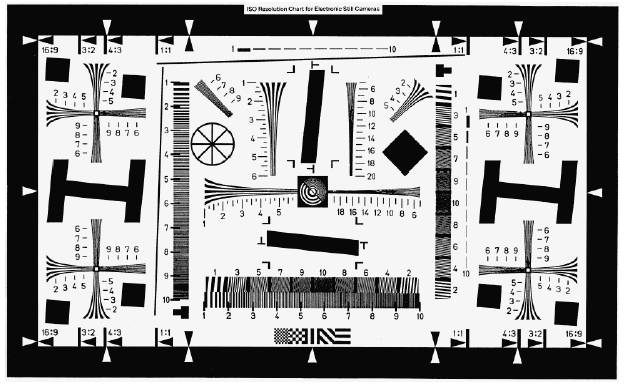 Camera resolution test chart from ISO 12233:2000
Camera resolution test chart from ISO 12233:2000
2. Camera resolution measurements
ISO/TC 42 has revised ISO 12233, now ISO 12233:2023, Photography — Electronic still picture imaging — Resolution and spatial frequency responses, with methods for measuring the resolution and the Spatial Frequency Response (SFR) of digital cameras.
The first edition, issued in 2000, provided a scientifically sound and easily accomplished standard way to measure the true optical resolution performance of any digital camera image of the test target shown above. The protocols in this standard debunk the use of pixel count (megapixels) as a representation of camera resolution.
Spatial frequency response (SFR) refers to the use of a slanted-edge gradient technique for capturing a super-resolution edge profile and transforming this into a spatial frequency signature. This approach greatly enhances imaging performance diagnostics to measure lens blur, sharpening and potential aliasing.
Hyperbolic wedge refers to features on the resolution test chart for quickly and more reliably assessing the limiting optical resolution visually. Rather than using a traditional radial grating feature (for example a starburst pattern) in which line spacing increases linearly with distance, the line spacing of a hyperbolic wedge increases linearly with spatial frequency. This effectively stretches high-frequency regions, to enable more precise resolution assessment.
ISO 12233 has been revised by ISO TC 42/WG 18. Notable enhancements in the 2023 edition include:
- Polynomial edge-fitting to accommodate spatially distorted images
- Correction for the edge angle (sampling of the edge profile)
- Adoption of the Tukey smoothing window for the e-SFR calculation
- Updated test chart with wider range of edge angles for analysis.
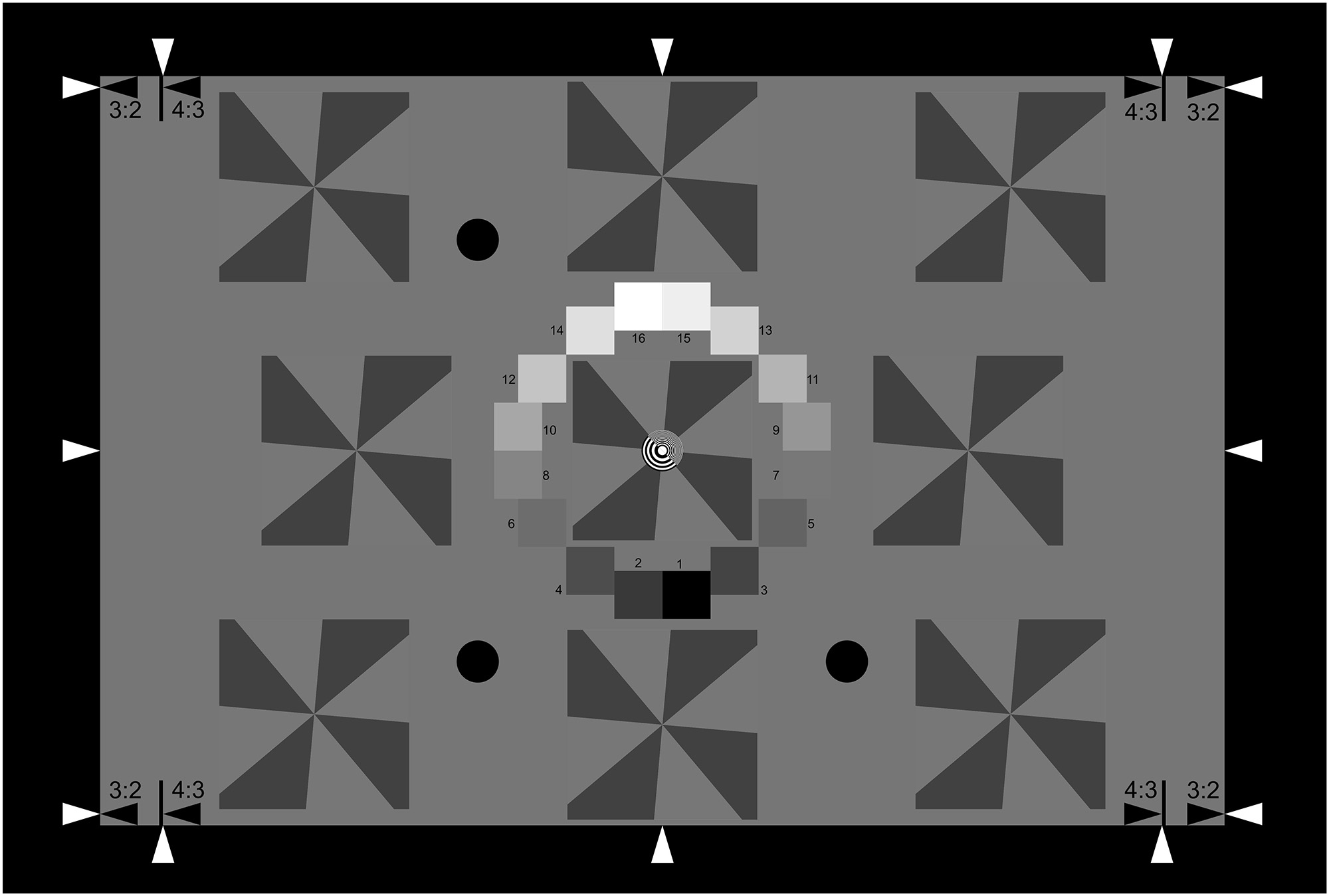 New e-SFR chart with 4:1 edge reflectance ratio, ISO 12233:2023
New e-SFR chart with 4:1 edge reflectance ratio, ISO 12233:2023
 Low contrast edge SFR chart from ISO 12233:2017
Low contrast edge SFR chart from ISO 12233:2017
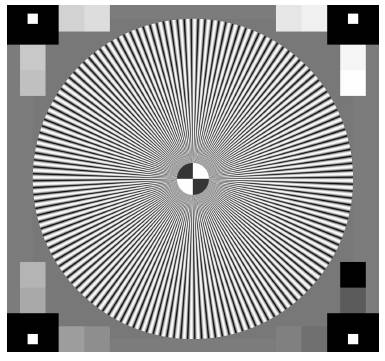 Sinusoidal Siemens star SFR chart used to measure s-SFR
Sinusoidal Siemens star SFR chart used to measure s-SFR
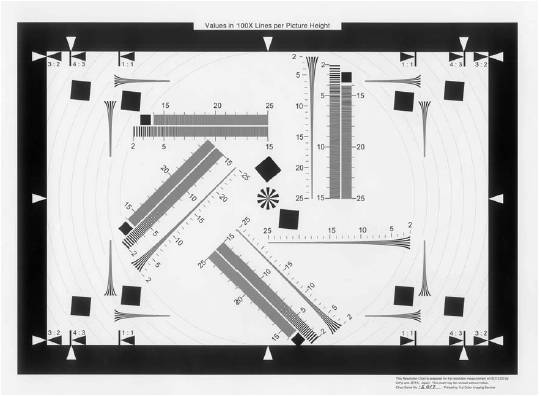 Visual resolution chart
Visual resolution chart
3. Scanner resolution measurements
ISO/TC 42 develops standards for measuring the resolution of reflection print scanners and film scanners. The available standards are:
ISO 16067-1:2003 Photography — Spatial resolution measurements of electronic scanners for photographic images — Part 1: Scanners for reflective media, which specifies methods for measuring and reporting the spatial resolution of electronic scanners for continuous tone photographic prints. This standard is applicable to both monochrome and color reflection print scanners.
ISO 16067-2:2004 Photography — Electronic scanners for photographic images — Spatial resolution measurements — Part 2: Film scanners, which specifies methods for measuring and reporting the spatial resolution of electronic scanners for continuous tone photographic negatives and reversal (e.g. slide) films. This standard is applicable to both monochrome and color film scanners.
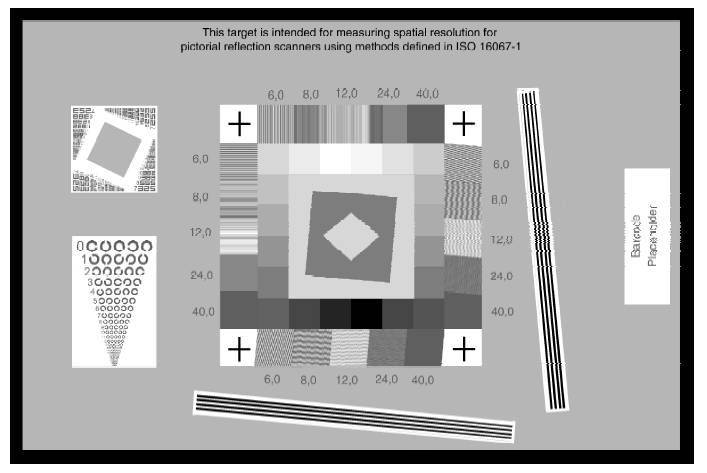 Scanner resolution test chart from ISO 16067-1: 2003
Scanner resolution test chart from ISO 16067-1: 2003
4. Measurement software
Experts from ISO/TC 42 have also developed software for performing the measurements specified in these resolution measurement standards.
4.1 Analysis software for the Siemens Star, Sinewave SFR (s-SFR) measurements.
Download .ZIP file
To run the executable you will also need the Matlab Compiler Runtime (MCR) which can be found here:
Matlab Compiler Runtime (MCR) Win 32
Matlab Compiler Runtime (MCR) Win 64
4.2 SFRMAT5 - Analysis software for the Edge SFR (e-SFR) measurements. Matlab source code, and information about the slanted-edge SFR method.
5. Sources for printed test charts
Applied Image Inc.
Image Engineering
Image Science Associates
Imatest LLC
6. Related papers published by IS&T
The following are links to IS&T papers that describe the development or use of these resolution measurement standards:
Development of ISO 12233
- Parulski, K., Wueller, D., Burns, P., and Yoshida, H., Creation and Evolution of ISO 12233, the International Standard for Measuring Digital Camera Resolution, IS&T Electronic Imaging: Image Quality and System Performance XIX Conference Proceedings (IS&T, Springfield, VA, 2022) pp. 347-1-347-7.
Origin and development of e-SFR
- Fischer, T. A. and Holm, J., Electronic still-picture camera spatial frequency response measurement, IS&T's 47th Annual Conference / ICPS 1994, vol. II, pp. 626-630.
- Okano, Y., MTF Analysis and its Measurements for Digital Still Camera, IS&T's 50th Annual Conference (1997), pp. 383-387.
- Williams, D., Benchmarking of the ISO 12233 Slanted-edge Spatial Frequency Response Plug-in, IS&T's PICS 1998, pp 133-136.
- Williams, D., Debunking of Specsmanship: Progress on ISO/TC42 Standards for Digital Imaging Performance, IS&T's PICS 2003, pp. 77-81.
- Burns, P., Masaoka, K., Parulski, K., and Wueller, D., Updated Camera Spatial Frequency Response for ISO 12233, IS&T Electronic Imaging: Image Quality and System Performance XIX Conference Proceedings (IS&T, Springfield, VA, 2022) pp. 357-1-357-6.
s-SFR
- Loebich, C., Wueller, D., Klingen, B. and Jaeger, A., Digital Camera Resolution Measurement Using Sinusoidal Siemens Stars, IS&T/SPIE Electronic Imaging 2007.
- Williams, D., Wueller, D., Matherson, K., Yoshida, H., and Hubel, P., A Pilot Study of Digital Camera Resolution Metrology Protocols Proposed under ISO 12233, Edition 2, IS&T/SPIE Electronic Imaging 2008.
Application and derived measures
- Okano, Y., Influence of Image Enhancement Processing on SFR of Digital Cameras, IS&T's PICS 1998 Final Program and Proceedings, pp. 74-78.
- Burns, P. and Williams, D., Using Slanted Edge Analysis for Color Registration Measurement, IS&T's PICS 1999 Final Program and Proceedings, pp. 51-53.
- Burns, P. and Williams, D., Sampling Efficiency in Digital Camera Performance Standards, IS&T/SPIE Electronic Imaging 2008.
- Burns, P., Williams, D., Griffith, J., Hall, H., and Cahall, S., Application of ISO Standard Methods to Optical Design for Image Capture, IS&T Electronic Imaging: Image Quality and System Performance XVII Conference Proceedings (IS&T, Springfield, VA, 2020), pp. 240-1-240-7









